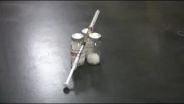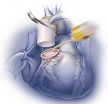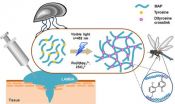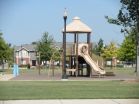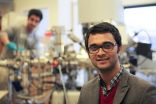New mussel-inspired surgical protein glue: Close wounds, open medical possibilities
2015-07-21
(Press-News.org) One of the most basic yet important surgical skills to keep a patient alive and intact may be closing wounds. It seems that doctors will now get the job done with more ease thanks to new, nontoxic surgical glue that instantly seals a bleeding wound and helps it heal without a scar or inflammation.
Inspired by nature's wonders, Korean scientists at Pohang University of Science and Technology (POSTECH) have developed a light-activated, mussel protein-based bioadhesive (LAMBA) that works on the same principles as mussels attaching to underwater surfaces and insects maintaining structural balance and flexibility. The product, called LAMBA, has emerged as a promising candidate for an ideal bioadhesive for its outstanding properties; LAMBA's compatibility with the human body, strong adhesiveness in wet conditions, and convenient handling point to the possibility of myriad medical applications.
Mechanical fasteners like sutures and staples have accounted until recently for a major portion of conventional medical devices that are used to hold body tissues together. The invasive nature of traditional methods, however, has been the biggest drawback causing severe tissue damage, complicated post-treatment management, and scars. Their use is also limited when handling delicate tissues and internal organs, giving rise to a need for alternatives that do not require penetration. Tissue adhesives have been increasingly pursued these days as a more desirable bonding material, but the adhesives currently available in the market likewise have their own limitations. While chemically derived adhesives such as cyanoacrylates are likely to provoke an adverse reaction, biologically derived ones are not strong enough to close wounds like sutures do. A common and critical challenge, moreover, is that most surgical glues do not stick in a wet environment, which is essential for medical applications.
Dr. Hyung Joon Cha, a professor of the Department of Chemical Engineering at POSTECH, and his student, Eun Young Jeon, have developed a new approach that readily overcomes these drawbacks. The new product LAMBA, a focus of their recent publication in Biomaterials, is an upgrade version of previously known mussel-inspired adhesives that copy mussels' ability to fix their body under water. Instead of producing recombinant mussel adhesive proteins (MAPs) by modifying DOPA, a key element for the adhesive property, E.Y. Jeon et al., have created the new tissue adhesive via a photochemical reaction using blue visible light.
E.Y. Jeon et al gained the idea for this more economic, facile, and reliable strategy from dityrosine crosslinks that are often found in dragonfly wings and insect cuticles. When visible light triggers a photo-oxidation reaction in MAPs plentiful of tyrosine, neighboring tyrosine residues are instantly coupled into dityrosine crosslinks, which in turn enhance structural stability and adhesive properties of the new MAPs in the form of hydrogel.
The researchers report in their article published in Biomaterials that animal studies have proved LAMBA's superiority to existing options including sutures and other surgical glues, potentially qualifying for an ideal tissue bonding material. The new adhesive hydrogel not only closes an open wound on a bleeding site within less than 60 seconds, but also effectively facilitates the healing process without inflammation or a scar.
"LAMBA opens numerous doors for medical practices ranging from blocking air leaks and sutureless wound closures of delicate organs or tissues beyond surgeons' reach, to hemostatic agent and drug delivery medium, just to name a few," commented Dr. Cha, a corresponding author of this study.
INFORMATION:
This work was supported by the Marine Biotechnology program of Ministry of Oceans and Fisheries, Korea. The main author, E.Y.J was supported by Global PH.D Fellowship program funded by the Ministry of Education, Korea.
ELSE PRESS RELEASES FROM THIS DATE:
2015-07-21
PROVIDENCE, R.I. [Brown University] -- When the HOPE VI community revitalization project in the disadvantaged Birmingham, Ala., neighborhood of Ensley reached the phase of building walking and biking paths, green spaces, and improved lighting in 2010, two things happened, according to a new study: First, residents developed specific expectations that leisure exercise would become more plausible, and then they followed through and got out there.
Before the neighborhood's revitalization, launched in 2006 with funding from the federal program Housing Opportunities for People ...
2015-07-21
A vaccine that protects against a wide variety of influenza viruses (a so-called universal flu vaccine) is a critical public health goal given the significant rates of illness and death caused by seasonal influenza and the potentially devastating effects of a pandemic influenza strain. Now, researchers from the National Institute of Allergy and Infectious Diseases (NIAID), part of the National Institutes of Health, have devised a way to induce protective immunity in mice against a wide array of influenza viruses.
Instead of trying to predict which influenza virus strains ...
2015-07-21
This news release is available in German. In 2003, Europe experienced a record-breaking summer, and many people feel that this summer is headed the same way. In the midst of this heatwave, the scientific journal Nature Geoscience has published a study that can help us to understand such extreme weather conditions. For around two years, an ETH research team has analysed climate data from all over the world in a bid to explain the driving force behind stable high-pressure systems. It has long been known that extremely stable high-pressure systems in the upper troposphere, ...
2015-07-21
Researchers at the Babraham Institute and Cambridge Systems Biology Centre, University of Cambridge have shown that yeast can modify their genomes to take advantage of an excess of calories in the environment and attain optimal growth.
The ability to sense environmental nutrient availability and act accordingly is a critical process for all organisms. Changing behaviour in response to nutrients can occur at many levels: the activity of proteins can be varied or new genes can be activated to produce a different set of proteins. Research published in the latest issue of ...
2015-07-21
A majority of men who have sex with men (MSM) and transgender women (TGW) at high risk for HIV infection took anti-HIV medication for pre-exposure prophylaxis (PrEP), most of the time, in a multi-site U.S. study examining use of this HIV prevention strategy outside of a clinical trial. The study, called the PrEP Demo Project, was funded by the National Institute of Allergy and Infectious Diseases (NIAID), part of the National Institutes of Health.
The study findings will be presented by Albert Liu, M.D., of the San Francisco Department of Public Health, at the 8th International ...
2015-07-21
Children born with ADNP-related autism syndrome suffer from a heart-breaking combination of ambiguous developmental problems injurious to both their physical health and cognitive functioning. For parents, the mystery surrounding their infants' suffering can be even more agonizing than the syndrome itself, which has no known cure.
Recent research from Tel Aviv University and the University of Antwerp is easing some of that agony. Activity-dependent neuroprotective protein (ADNP), discovered by TAU's Prof. Illana Gozes 15 years ago, has now been shown by Prof. Frank Kooy ...
2015-07-21
One of the enduring mysteries of the human experience is how and why humans moved from hunting and gathering to farming.
From their beginnings humans, like other mammals, depended on wild resources for sustenance. Then between 8,000 and 12,000 years ago, in a transitional event known as the Neolithic Revolution, they began to create and tend domestic ecosystems in various locations around the world, and agriculture was born.
Despite decades of research into this major human advancement, scientists still don't know what propelled it.
The recent work of a research ...
2015-07-21
WASHINGTON, DC - July 21, 2015 - Each year, scientists create an influenza (flu) vaccine that protects against a few specific influenza strains that researchers predict are going to be the most common during that year. Now, a new study shows that scientists may be able to create a 'universal' vaccine that can provide broad protection against numerous influenza strains, including those that could cause future pandemics. The study appears in mBio, the online open-access journal of the American Society for Microbiology.
"The reason researchers change the vaccine every year ...
2015-07-21
WASHINGTON -- Advertisers hoping to sway consumers might want to rethink running spots within media with violent or sexual themes, and might do better if the ads themselves have a G-rating, according to a study published by the American Psychological Association. Instead, violent and sexual media content may impair advertising's effectiveness and ultimately deter purchasing, the research found.
"We found almost no evidence that violent and sexual programs and ads increased advertising effectiveness," said Brad J. Bushman, PhD, professor of communication and psychology ...
2015-07-21
Believe it or not: X-ray works a lot better on rocks than on paper. This has been a problem for conservators trying to save historical books and letters from the ravages of time and fungi. They frankly did not know what they were up against once the telltale signs of vandals such as Dothidales or Pleosporales started to spot the surface of their priceless documents
Now Diwaker Jha, an imaging specialist from Department of Chemistry, University of Copenhagen, has managed to adapt methods developed to investigate interiors of rocks to work on paper too, thus getting a ...
LAST 30 PRESS RELEASES:
[Press-News.org] New mussel-inspired surgical protein glue: Close wounds, open medical possibilities
